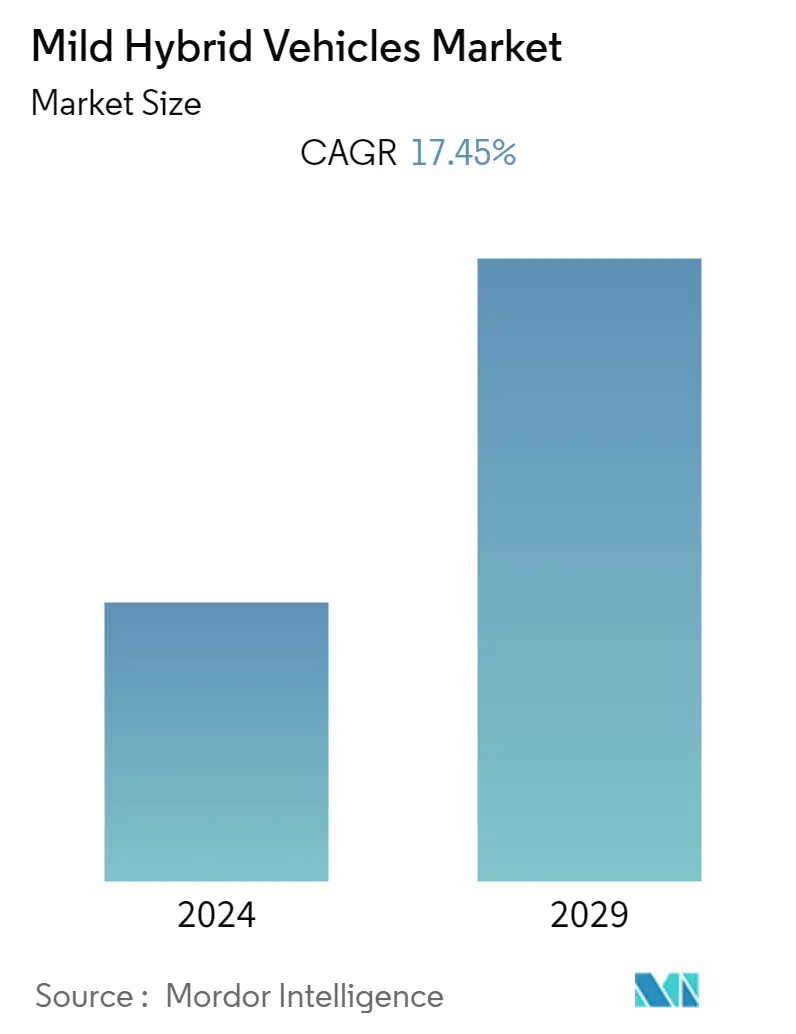Market Size of Mild Hybrid Vehicles Industry

| Study Period | 2019 - 2029 |
| Base Year For Estimation | 2023 |
| CAGR | 17.45 % |
| Fastest Growing Market | Asia-Pacific |
| Largest Market | Asia-Pacific |
| Market Concentration | Medium |
Major Players
*Disclaimer: Major Players sorted in no particular order |
Mild Hybrid Vehicles Market Analysis
The Mild Hybrid Vehicles Market size is estimated at USD 100.35 billion in the current year. It is expected to reach USD 224.27 billion within the next five years, registering a CAGR of 17.45% during the forecast period.
Stringent emission standards, fuel efficiency, and government incentives are the major factors driving automakers and buyers to shift toward hybrid vehicles from conventional vehicles. However, demand for battery-electric vehicles is growing significantly, which might hinder the growth of the mild hybrid vehicle market.
Asia-Pacific is expected to grow faster during the forecast period. However, certain trends in emerging countries, like India, may hinder the sales growth of hybrid vehicle types as the country recently removed the subsidy for mild hybrid vehicles under the FAME scheme. North America and Europe are expected to witness considerable growth for mild hybrid vehicles as these regions are focusing more on the growth of pure electric or full hybrid vehicles.
Mild Hybrid Vehicles Industry Segmentation
Mild hybrid vehicles contain an internal combustion engine (ICE) equipped with an electric motor. It allows the engine to be turned off whenever the vehicle is coasting, braking, or stopped and restart quickly. Mild hybrid vehicles do not include an exclusive electric-only mode of propulsion. These vehicles employ regenerative braking and some level of power assist to the ICE. The features above of mild hybrid vehicles are considered in the scope of the market.
The mild hybrid vehicles market is segmented by capacity, vehicle type, and geography. By capacity, the market is segmented into less than 48V and 48V and above. Based on vehicle type, the market is segmented into passenger cars and commercial vehicles. By geography, the market is segmented into North America, Europe, Asia-Pacific, and the rest of the World. The mild hybrid vehicles market size and forecast will be provided in value (USD).
| Capacity Type | |
| Less than 48V | |
| 48V and Above |
| Vehicle Type | |
| Passenger Car | |
| Commercial Vehicle |
| Geography | ||||||
| ||||||
| ||||||
| ||||||
|
Mild Hybrid Vehicles Market Size Summary
The mild hybrid vehicles market is experiencing significant growth, driven by factors such as stringent emission standards, the need for improved fuel efficiency, and government incentives. These elements are encouraging both automakers and consumers to transition from conventional vehicles to hybrid options. Despite the rising demand for battery-electric vehicles, which poses a challenge to the mild hybrid segment, the market is poised for substantial expansion. The Asia-Pacific region is anticipated to lead this growth, although recent policy changes in countries like India may impact the market dynamics. In contrast, North America and Europe are focusing on the development of pure electric and full hybrid vehicles, which could influence the growth trajectory of mild hybrids in these regions.
The adoption of 48V mild hybrid technology is gaining momentum, with major automakers such as Mercedes-Benz, Audi, and BMW integrating this system into their new models. This technology offers cost-effective benefits similar to full hybrids, making it an attractive option for larger vehicles like SUVs and trucks. The market is further bolstered by the introduction of vehicles with less than 48V capacity, as manufacturers respond to increasing consumer demand. In the Asia-Pacific region, particularly China, the market is supported by high vehicle sales and investments from automotive companies. Government initiatives in India, aimed at promoting electric mobility, are also expected to enhance mild hybrid vehicle sales. Key players in the market include Nissan, Volkswagen, Suzuki, Hyundai, Ford, and Toyota, all contributing to the growing demand through new product launches.
Mild Hybrid Vehicles Market Size - Table of Contents
-
1. MARKET DYNAMICS
-
1.1 Market Drivers
-
1.1.1 Fuel Efficiency and Emissions Reduction
-
1.1.2 Government Regulations and Incentives
-
-
1.2 Market Restraints
-
1.2.1 Competing Alternative Technologies
-
-
1.3 Industry Attractiveness - Porter's Five Forces Analysis
-
1.3.1 Bargaining Power of Suppliers
-
1.3.2 Bargaining Power of Buyers/Consumers
-
1.3.3 Threat of New Entrants
-
1.3.4 Threat of Substitute Products
-
1.3.5 Intensity of Competitive Rivalry
-
-
-
2. MARKET SEGMENTATION
-
2.1 Capacity Type
-
2.1.1 Less than 48V
-
2.1.2 48V and Above
-
-
2.2 Vehicle Type
-
2.2.1 Passenger Car
-
2.2.2 Commercial Vehicle
-
-
2.3 Geography
-
2.3.1 North America
-
2.3.1.1 US
-
2.3.1.2 Canada
-
2.3.1.3 Rest of North America
-
-
2.3.2 Europe
-
2.3.2.1 Germany
-
2.3.2.2 UK
-
2.3.2.3 France
-
2.3.2.4 Rest of Europe
-
-
2.3.3 Asia-Pacific
-
2.3.3.1 China
-
2.3.3.2 Japan
-
2.3.3.3 India
-
2.3.3.4 Rest of Asia-Pacific
-
-
2.3.4 Rest of the World
-
2.3.4.1 Brazil
-
2.3.4.2 South Africa
-
2.3.4.3 Other Countries
-
-
-
Mild Hybrid Vehicles Market Size FAQs
What is the current Mild Hybrid Vehicles Market size?
The Mild Hybrid Vehicles Market is projected to register a CAGR of 17.45% during the forecast period (2024-2029)
Who are the key players in Mild Hybrid Vehicles Market?
Nissan Motor Co. Ltd, Suzuki Motor Corporation, Volkswagen AG, Hyundai Motor Company and Ford Motor Company are the major companies operating in the Mild Hybrid Vehicles Market.

